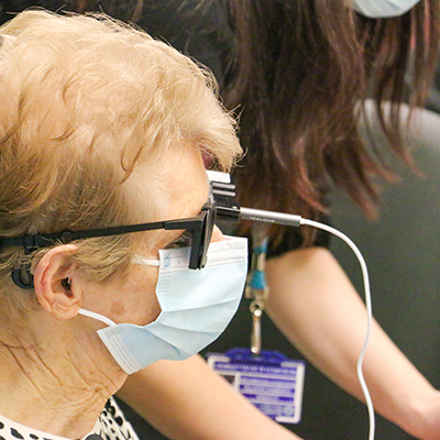Q&A - your questions answered on the PRIMA System clinical trial for dry AMD
Posted: Monday 20 October 2025
People with late-stage dry age-related macular degeneration (AMD) who previously had no central vision at all have been able to read letters, numbers and words thanks to an implantable device.
Results from the PRIMA System clinical trial have been published, revealing 84.4% of those in the study regained the ability to read letters, numbers, and words. On average, patients were able to read up to five lines on an eye chart.
Here we answer your questions on Science Corporation's PRIMA System and what could happen next.
What do the results show?
Following the results of the clinical trial for dry AMD, in October 2025 the PRIMA System was hailed as the first implantable device to enable people to read using an eye that had lost sight.
A total of 38 patients took part in the trial across Europe, including five at Moorfields Eye Hospital in London. These patients had no central vision before taking part, however 84.4% of those on the trial regained the ability to read letters, numbers, and words.
On average, patients were able to read up to five lines on an eye chart.
How does the PRIMA System work?
The PRIMA System consists of three elements; a wireless retinal implant, which is inserted under the patient's retina, a pair of glasses with a camera and digital projector, and a pocket processor.
The implant, captures the visual scene projected by the glasses and transmits this to the computer. Artificial intelligence (AI) algorithms process this information and instruct the glasses to focus on what it perceives to be the main object in the image. The glasses project this image as an infra-red beam through the eye to the chip, which converts this into an electrical signal. This signal passes through the retina cells and optical cells into the brain, where it is interpreted as if it were natural vision.
Who could the PRIMA System work for?
The PRIMA System is designed for anyone with advanced dry AMD who is at the end-stages of the condition. The trial tested patients who had a visual acuity of 6/96 or worse (equivalent to 20/320 or logMAR 1.2).
Can the PRIMA system help people with other types of macular disease as well as dry AMD?
According to Science Corporation, the PRIMA System could potentially help with all kinds of macular conditions, and retinal diseases where photoreceptors are degenerated, but the other nerve cells of the retina are still intact.
However, it has only reached the clinical trial stage for patients with advanced dry AMD. Clinical trials for retinitis pigmentosa (RP) and Stargardt disease, are considered to be in ‘future development’ at this stage.
How widely could this be available?
Science Corporation have submitted an application for a CE mark. The CE mark indicates that a device complies with relevant European Union regulations, including health and safety standards. The CE mark is recognised in the UK and, if obtained, the company will be able to market the PRIMA System in this country.
How much will it cost and could it be available on the NHS?
Pricing of the device has not yet been defined and it is unknown if it could be available on the NHS. There have been no other devices on the market previously and available on the NHS, but the company remains optimistic.
If you're interested in the device yourself, please visit the Moorfields website, where you can register for your email address to be passed on to Science Corporation.
I would like to take part in a clinical trial for AMD, who do I contact?
You can register your interest in research trials at Moorfields by signing up to research opportunities.
You can also register with the Macular Society to hear about clinical trials by joining our Research Participant Database.
Revolutionary implant allows patients with dry AMD to read again
A revolutionary new implant has restored some vision to patients with dry age-related macular degeneration (AMD), enabling them to read words and numbers, boosting hopes of a breakthrough treatment.
Get involved in research
Patients have a very important part to play in medical research. Without them we would not have the treatments we have today and new and improved treatments would not be possible.




